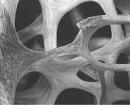
| Home | |
Investigators |
|
 |
|
|
|
||||
Bone CancerThere are two types of bone cancer; primary and secondary cancer. Primary bone cancer develops in the bones and is fortunately very rare. Secondary cancer is more common and is the result of cells becoming detached from a cancer elsewhere in the body. Two main types of primary cancer occur in bones; cancers of the bone marrow (myeloma, lymphoma or leaukemia - not dealt with here) and cancer of the bones themselves, normally called sarcomas. There are a number of different types of malignant bone tumours - Osteosarcoma, Ewing's sarcoma, Chondrosarcoma and Spindle cell sarcoma. How can bone cancer be diagnosed? The cancer can usually be seen on an Xray, but an isotope bone scan, MRI (Magnetic Resonance Imaging) scan or CT (Computed tomography) scan may also be used. Blood tests will indicate the level of calcium or any problems with bone marrow. How is it treated? Primary bone cancer can be treated by an appropriate combination of radiotherapy, chemotherapy and surgery depending on the type of tumour.
The cells travel in the blood or lymph and become lodged in the bone, most frequently in the central part of the skeleton such as the spine, pelvis or hip. Almost any cancer can spread to bone but the most common are lung, breast or prostate cancer. When cancer cells spread like this to another part of the body it is called metastasis. What are the symptoms? The most important symptom is pain - a dull ache in the bones which gets worse at night. In addition there may be raised calcium levels which cause tiredness, nausea and confusion.If the cancer causes localised bone destruction, broken bones (fractures) can occur. If the cancer affects the bone marrow, the production of new blood cells may be affected causing anaemia. How can bone cancer be diagnosed? The cancer canusually be seen on an Xray, but a bone scan, MRI scan or CT scan may also be used. Blood tests will indicate the level of calcium or any problems with bone marrow. How is it treated? The treatment of secondary bone cancer partly depends on the site of the primary cancer, if this is not already known tests will be carried out to identify it. Treatment will be an appropriate combination of hormone therapy, chemotherapy an/or radiotherapy depending on the site and severity of the cancer. Bisphosphonates are also frequently given, by mouth or by intravenous drip, to reduce bone pain and to lessen the chances of high blood levels of calcium and broken bones. Bisphosphonates work by reducing the number and action of the osteoclasts, thus slowing down the process of bone breakdown. Lost bone cannot be replaced but bisphosphonates can strengthen existing bone and reduce the damage caused by secondary bone cancer. More information NHS
Direct - bone cancer |
||||
| Text only | Accessibility | Search | Contact |